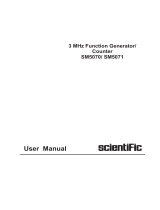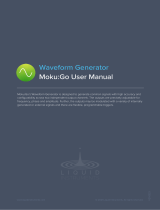Page is loading ...

This manual contains proprietary information, which is protected by
copyright. All rights are reserved. No part of this manual may be
photocopied, reproduced or translated to another language without
prior written consent of Good Will Corporation.
The information in this manual was correct at the time of printing.
However, Good Will continues to improve its products and therefore
reserves the right to change the specifications, equipment, and
maintenance procedures at any time without notice.
Good Will Instrument Co., Ltd.
No. 7-1, Jhongsing Rd., Tucheng Dist., New Taipei City 236, Taiwan.

Table of Contents
1
Table of Contents
SAFETY INSTRUCTIONS .................................. 2
GETTING STARTED .......................................... 7
Main Features ..................................................................... 7
Panel Overview .................................................................... 9
Setting Up the function Generator ..................................... 15
QUICK REFERENCE ....................................... 17
How to use the Digital Inputs ........................................... 19
How to use the Help Menu ............................................... 21
Selecting a Waveform ........................................................ 23
Modulation ........................................................................ 25
Sweep ................................................................................ 30
Burst ................................................................................. 31
ARB ................................................................................... 33
Utility Menu ...................................................................... 36
Frequency Counter ............................................................. 37
Coupling ............................................................................ 38
Menu Tree ......................................................................... 40
Default Settings ................................................................ 48
AFG-2225 Specifications .................................................... 50
EC Declaration of Conformity ............................................ 54

AFG-2225 Quick Start Guide
2
SAFETY INSTRUCTIONS
This chapter contains important safety instructions
that should be followed when operating and
storing the function generator. Read the following
before any operation to ensure your safety and to
keep the function generator in the best condition.
Safety Symbols
These safety symbols may appear in this manual or on the
instrument.
WARNING
Warning: Identifies conditions or practices that
could result in injury or loss of life.
CAUTION
Caution: Identifies conditions or practices that
could result in damage to the function generator or
to other objects or property.
DANGER High Voltage
Attention: Refer to the Manual
Protective Conductor Terminal
Earth (Ground) Terminal
DANGER Hot Surface

Safety Instructions
3
Double Insulated
Do not dispose electronic equipment as unsorted
municipal waste. Please use a separate collection
facility or contact the supplier from which this
instrument was purchased.
Safety Guidelines
General
Guideline
CAUTION
Do not place heavy objects on the instrument.
Do not place flammable objects on the
instrument.
Avoid severe impact or rough handling that
may damage the function generator.
Avoid discharges of static electricity on or near
the function generator.
Use only mating connectors, not bare wires, for
the terminals.
The instrument should only be disassembled by
a qualified technician.
(Measurement categories) EN 61010-1:2010 specifies the
measurement categories and their requirements as follows. The
AFG-2225 falls under category II.
Measurement category IV is for measurement performed at the
source of a low-voltage installation.
Measurement category III is for measurement performed in a
building installation.
Measurement category II is for measurement performed on
circuits directly connected to a low voltage installation.
Measurement category I is for measurements performed on
circuits not directly connected to Mains.
Power Supply
WARNING
AC Input voltage: 100 ~ 240V AC, 50 ~ 60Hz.
Connect the protective grounding conductor of
the AC power cord to an earth ground to
prevent electric shock.

AFG-2225 Quick Start Guide
4
Fuse
WARNING
Fuse type: F1A/250V.
Only qualified technicians should replace the
fuse.
To ensure fire protection, replace the fuse only
with the specified type and rating.
Disconnect the power cord and all test leads
before replacing the fuse.
Make sure the cause of fuse blowout is fixed
before replacing the fuse.
Cleaning the
function
generator
Disconnect the power cord before cleaning the
function generator.
Use a soft cloth dampened in a solution of mild
detergent and water. Do not spray any liquid
into the function generator.
Do not use chemicals containing harsh products
such as benzene, toluene, xylene, and acetone.
Operation
Environment
Location: Indoor, no direct sunlight, dust free,
almost non-conductive pollution (Note below)
and avoid strong magnetic fields.
Relative Humidity: < 80%
Altitude: < 2000m
Temperature: 0°C to 40°C

Safety Instructions
5
(Pollution Degree) EN 61010-1:2010 specifies pollution degrees and
their requirements as follows. The function generator falls under
degree 2.
Pollution refers to “addition of foreign matter, solid, liquid, or
gaseous (ionized gases), that may produce a reduction of dielectric
strength or surface resistivity”.
Pollution degree 1: No pollution or only dry, non-conductive
pollution occurs. The pollution has no influence.
Pollution degree 2: Normally only non-conductive pollution
occurs. Occasionally, however, a temporary conductivity caused
by condensation must be expected.
Pollution degree 3: Conductive pollution occurs, or dry,
non-conductive pollution occurs which becomes conductive due
to condensation which is expected. In such conditions,
equipment is normally protected against exposure to direct
sunlight, precipitation, and full wind pressure, but neither
temperature nor humidity is controlled.
Storage
environment
Location: Indoor
Relative Humidity: < 70%
Temperature: -10°C to 70°C
Disposal
Do not dispose this instrument as unsorted
municipal waste. Please use a separate collection
facility or contact the supplier from which this
instrument was purchased. Please make sure
discarded electrical waste is properly recycled to
reduce environmental impact.

AFG-2225 Quick Start Guide
6
Power cord for the United Kingdom
When using the function generator in the United Kingdom, make sure the
power cord meets the following safety instructions.
NOTE: This lead/appliance must only be wired by competent persons
WARNING: THIS APPLIANCE MUST BE EARTHED
IMPORTANT: The wires in this lead are coloured in accordance with the
following code:
Green/ Yellow:
Earth
Blue:
Neutral
Brown:
Live (Phase)
As the colours of the wires in main leads may not correspond with the
coloured marking identified in your plug/appliance, proceed as follows:
The wire which is coloured Green & Yellow must be connected to the Earth
terminal marked with either the letter E, the earth symbol or coloured
Green/Green & Yellow.
The wire which is coloured Blue must be connected to the terminal which is
marked with the letter N or coloured Blue or Black.
The wire which is coloured Brown must be connected to the terminal
marked with the letter L or P or coloured Brown or Red.
If in doubt, consult the instructions provided with the equipment or contact
the supplier.
This cable/appliance should be protected by a suitably rated and approved
HBC mains fuse: refer to the rating information on the equipment and/or
user instructions for details. As a guide, a cable of 0.75mm2 should be
protected by a 3A or 5A fuse. Larger conductors would normally require 13A
types, depending on the connection method used.
Any exposed wiring from a cable, plug or connection that is engaged in a live
socket is extremely hazardous. If a cable or plug is deemed hazardous, turn
off the mains power and remove the cable, any fuses and fuse assemblies. All
hazardous wiring must be immediately destroyed and replaced in
accordance to the above standard.

Getting Started
7
GETTING STARTED
The Getting started chapter introduces the
function generator’s main features, appearance, set
up procedure and power-up.
Main Features
Model
Bandwidth
AFG-2225
25MHz
Performance
DDS function generator series
1μHz high frequency resolution maintained at
full range
20ppm frequency stability
Arbitrary waveform capability
120 MSa/S sample rate
60 MSa/S repetition rate
4k point waveform length
10 groups of 4k waveform memories
True waveform output to display
User defined output section
DWR (Direction Waveform Reconstruction)
Waveform editing via PC.
Features
Sine, Square, Ramp, Pulse, Noise, standard
waveforms
Internal and external LIN/LOG sweep with
marker output
Int/Ext AM, FM, PM, FSK, SUM modulation

AFG-2225 Quick Start Guide
8
Burst function with internal and external
triggers without marker output
Store/recall 10 groups of setting memories
Output overload protection
Interface
USB interface as standard
3.5” color TFT LCD (320× 240) graphical user
interface.
AWES (Arbitrary Waveform Editing Software)
PC software

Getting Started
9
Panel Overview
Front Panel
turn
/
AFG-2225
LCD Display Function keys,
Return key
Scroll Wheel Output
Terminals
Number pad Power
switch
Output key
Channel
select key
Arrow keys
Operation keys
LCD Display
TFT color display, 320 x 240 resolution.
Function Keys
F1~F5
Activates functions which appear
on the right-hand side of the LCD
display.
Return Key
turn
Goes back to the previous menu
level.
Operation Keys
The waveform key is used to select
a type of waveform.
/
The FREQ/Rate key is used to set
the frequency or sample rate.
AMPL sets the waveform
amplitude.
Sets the DC offset.

AFG-2225 Quick Start Guide
10
The UTIL key is used to access the
save and recall options, update and
view the firmware version, access
the calibration options, dual
channel settings and frequency
meter.
ARB is used to set the arbitrary
waveform parameters.
The MOD, Sweep and Burst keys
are used to set the modulation,
sweep and burst settings and
parameters.
Preset Key
The preset key is used to recall a
preset state.
Output Key
The Output key is used to turn on
or off the waveform output.
Channel Select
Key
The channel select key is used to
switch between the two output
channels.
Output ports
CH1: Channel 1 output port
CH2: Channel 2 output port
Power Button
Turns the power on or off.
Arrow Keys
Used to select digits when editing
parameters.

AFG-2225 Quick Start Guide
12
Rear Panel
rr
ountr
rr
ost
v
USB A port Trigger output
Input Terminals
USB B port
FanPower socket input
Trigger Input
rr
ountr
rr
External trigger input. Used to
receive external trigger signals.
Trigger Output
rr
ountr
rr
Marker output signal. Used for
Sweep, Burst and ARB mode only.
Fan
Fan.
Power Input
Socket
Power input: 100~240V AC
50~60Hz.

AFG-2225 Quick Start Guide
14
Display
Soft Menu
Keys
Status Tabs
Parameter
Windows
Waveform
Display
Parameter
Windows
The Parameter display and edit window.
Status Tabs
Displays the current channel and setting status.
Waveform Display
Used to display the waveform
Soft Menu Keys
The function keys (F1~F5) beside the Soft Menu
keys correspond to the soft keys.

Getting Started
15
Setting Up the function Generator
Background
This section describes how adjust the handle and
power up the function generator.
Adjusting the
Handle
Pull out the handle
sideways and rotate
it.
turn
/
AFG-2225
Place the AFG-2225
horizontally,
Or tilt the stand.
Place the handle
vertically to hand
carry.

AFG-2225 Quick Start Guide
16
Power Up
1. Connect the power cord to
the socket on the rear panel.
2. Turn on the power switch
on the front panel.
turn
/
AFG-2225
3. When the power switch is turned on the screen
displays the loading screen.
The function generator is now ready to be used.

Quick Reference
17
QUICK REFERENCE
This chapter describes the operation shortcuts, built-in help and
factory default settings. This chapter is to be used as a quick
reference, for detailed explanations on parameters, settings and
limitations, please see the user manual.
How to use the Digital Inputs ........................................... 19
How to use the Help Menu ............................................... 21
Selecting a Waveform ........................................................ 23
Square Wave ......................................................................... 23
Ramp Wave .......................................................................... 23
Sine Wave ............................................................................. 24
Modulation ........................................................................ 25
AM ........................................................................................ 25
FM ........................................................................................ 26
FSK Modulation.................................................................... 27
PM Modulation .................................................................... 28
SUM Modulation .................................................................. 29
Sweep ................................................................................ 30
Burst ................................................................................. 31
ARB ................................................................................... 33
ARB–Add Built-In Waveform ................................................ 33
ARB- Add Point ..................................................................... 33
ARB- Add Line ...................................................................... 34
ARB– Output Section ........................................................... 34
Utility Menu ...................................................................... 36
Save ...................................................................................... 36
Recall .................................................................................... 36
Frequency Counter ............................................................... 37
Frequency Coupling ............................................................. 38
Amplitude Coupling ............................................................. 38
Tracking ................................................................................ 39
Menu Tree ......................................................................... 40
Waveform ............................................................................. 40

AFG-2225 Quick Start Guide
18
ARB-Display .......................................................................... 41
ARB-Edit ............................................................................... 42
ARB- Built In ......................................................................... 42
ARB-Save .............................................................................. 43
ARB-Load .............................................................................. 43
ARB-Output .......................................................................... 44
MOD .................................................................................... 44
SWEEP .................................................................................. 45
SWEEP- More ....................................................................... 45
Burst- N Cycle ...................................................................... 46
Burst – Gate ......................................................................... 46
UTIL ...................................................................................... 47
CH1/CH2 ............................................................................. 47
Default Settings ................................................................. 48
AFG-2225 Specifications .................................................... 50
EC Declaration of Conformity ............................................ 54
/






